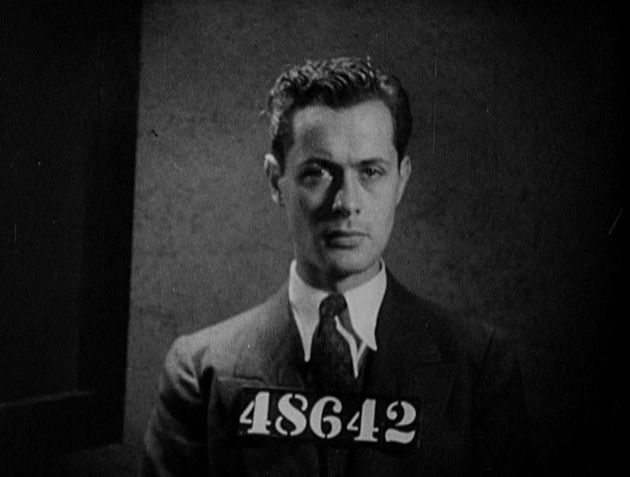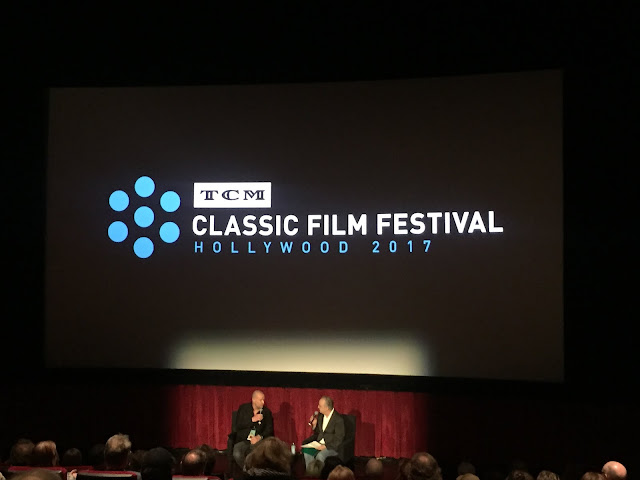 |
| Michael Douglas and Ben Mankiewicz at the 2017 TCMFF. Publicity Photo courtesy of Getty & TCM |
Timing is everything. Michael Douglas's nuclear thriller The China Syndrome (1979) debuted on March 16th, 1979 and twelve days later a nuclear meltdown occurred on 3 Mile Island. The fictional event and the real life one would forever be connected.
In the film Jane Fonda stars as Kimberly Wells, a TV news reporter relegated to covering fluff with dreams of breaking a big story. When her and her news crew, including cameraman Richard Adams (Michael Douglas), are working on a report at a local nuclear power plant, a tremor signals an emergency with the plant's reactor. Shift supervisor Jack Godell (Jack Lemmon) is the only who understands the severity of the situation. Jack faces a major fight against the head honchos and staff at the plant who don't believe him and will do anything to prevent a public scandal. With the help of Wells and her crew, Jack makes a valiant attempt to reveal the truth and save the plant and the community before it's too late.
I had the honor of being in attendance of a special screening of The China Syndrome (1979) at the 2017 TCM Classic Film Festival. The movie had me on the edge of my seat. It's a fantastic thriller with a timely message. Following the movie, we were treated to Ben Mankiewicz interview of actor/producer Michael Douglas.
It all started with a packet in the mail. Douglas remembered, "this script came to me unsolicited by a guy name Mike Grey who was a documentary filmmaker out of Chicago who had done a movie called The Murder of Fred Hampton. That was a Black Panther leader who was murdered by Chicago Police. Mike's background was an engineer and he sent this script which really read as a brilliant horror movie. And I looked at it as a scary horror movie with this power plant being the monster. It was only then after we committed to the picture and got involved with the verisimilitude of nuclear power that I became more of an advocate of this was the really issue that's defined the rest of my life in terms of the elimination of nuclear weapons."
Mankiewicz joked with Douglas that opening unsolicited material might be something people got away with in the 1970s but not today. As Douglas then noted unsolicited scripts can't be accepted because of legalities involved. So if you're thinking you can take Mike Grey's lead and send Michael Douglas your movie script, think again!
 |
| Jack Lemmon, Michael Douglas and Jane Fonda in The China Syndrome (1979) |
It took a while to get The China Syndrome going. Jack Lemmon was on board pretty early but he had to wait for almost a year to start working. During that time he set aside other projects. Douglas shared a funny memory of Lemmon. On the set, Lemmon couldn't get started with out his morning cup of coffee. Once he had his cuppa joe he'd perk right up and exclaim "it's magic time!" A cup of coffee is also key to the plot of the film.
Richard Dreyfuss was also on board to play the lead role of a TV news reporter. Douglas joked that, "Richard Dreyfuss had a couple of hits come out and all of a sudden Richard was gone." Director James Bridges and producer Douglas were scrambling to figure out how to replace Dreyfuss. Douglas shared the following story: "A studio executive [told us] 'Jane Fonda is developing the Karen Silkwood story here and maybe you guys should talk.' [They were] competing projects. Jane and I, with our familial histories sort of sized each other up. She was initially going to try to persuade me in some way to kill The China Syndrome ... And I was going to tell her that we were further ahead on The China Syndrome that you should put a dagger in Karen. Eventually it worked that we were ready to go and we changed Richard Dreyfuss' role and had it re-written." Karen Silkwood, a nuclear power plant employee who was preparing to leak information to the press, died in a car accident under mysterious circumstances. Her story was incorporated into The China Syndrome.
Mankiewicz pointed out that Douglas took his role as camera man Richard Adams very seriously. Douglas had studied with NBC camera man Bob Brown, who was shot down by members of the Peoples Temple shortly before Jonestown's infamous mass suicide.
When you watch the film you'll notice the eerie silence of the end credits. Director James Bridges and producer Michael Douglas had hired a composer for the film. But when the ran the reels without the music they discovered it was better without any music.
Once the film was in the can, Douglas and Bridges were ready to release it to the world. Douglas said, "It did very well actually for the kind of picture it was. However we did hold in there for the first week. [It was] heavily criticized. People said, 'how irresponsible of Hollywood to be doing a film on nuclear power!" Mankiewicz followed up by pointing out, "the campaign against this movie, Michael's underselling it I think a little bit, was very well organized. It was a corporate energy based organized protest to beat back this film."
Twelve days after the release, the 3 Mile Island nuclear power plant has a meltdown. Douglas said,
I tried to explain it that it was a complete epiphany to me. I'm not a religious person but I thought somebody's telling me something." Douglas and Bridges hired former General Electric quality assurance experts to help with the movie. According to Douglas "they had lost faith and went to the other side." The China Syndrome depicts a process of 150 logical computer steps and when Harry Latham, a writer for Esquire magazine, analyzed the process it was discovered that over 90% of the steps depicted in the movie were accurate. Did the publicity of the real life nuclear disaster help the movie? Not so much. Most people saw enough clips of the movie on the news or were too frightened by the real event to endure a movie about it.
The China Syndrome marked a turning point in Douglas' career. Douglas said, "it became part of my history of doing movies that had sort of a zeitgeist speaking about what's going on at the time. It has stuck with me as the most incredible in my career in terms of tying it with what was going on in real time.
During their conversation, Ben Mankiewicz and Michael Douglas spoke at length about Douglas' TV show The Streets of San Francisco. Douglas left in the fifth year of the show to produce One Flew Over the Cuckoo's Nest. Being let out of a TV contract like that was virtually unheard of. The show's star Karl Malden and producer Quinn Martin knew about much Cuckoo's Nest meant to Douglas. Being released from the show helped him launch his successful movie career.
Transitioning from being a TV actor to film was virtually unheard of at the time. According to Douglas, "the argument was that if you're there for free who's going to pay for you. So before me it was really only Steve McQueen and Clint Eastwood who had made the transition going from television to films."
Being on The Streets of San Francisco helped shape Douglas' methods and work ethic. In the interview he shared the following: "when you do a television series, we were in San Francisco and we were filming six days a week. In those days we did 26 hour shows in a season. Six days a week, 8 and a half months straight through. You're looking at these scripts that are coming in and you get pretty good about structure. You also get really good about working together as an ensemble and I take my hat off to Karl Malden. Who was such an extraordinary actor and such a team player that you learn that you are not the most important thing in the project. The material is the important. I'm an old-fashioned structuralist. I've learned from the prologue, three acts and epilogue. My first desire is to be moved if it's funny or sad. Secondly I analyze the material pretty carefully and see if it's structurally sound. Then my interests are all over the place depending where it may be."
Karl Malden took Douglas under his wing. According to Douglas, "in those days, the second banana was two feet back in soft focus" By season two, Karl Malden gave Douglas a more substantial role and let him lead some of the episodes. I love that Malden always called Douglas "buddy boy", a nickname that used to irk Douglas but now it's a name he fondly remembers.
 |
| My husband was especially excited to see Michael Douglas. Here he is watching his favorite actor in person. |
I feel very privileged to have been able to attend this special screening and to hear the legendary Michael Douglas in conversation. It was fascinating and definitely a highlight of the festival for me. I couldn't help but hear Kirk Douglas in the voice of his son. This will be as close as I'll ever get to the other legend!
Related link: Carlos' review of the book Michael Douglas: A Biography by Marc Eliot.





















